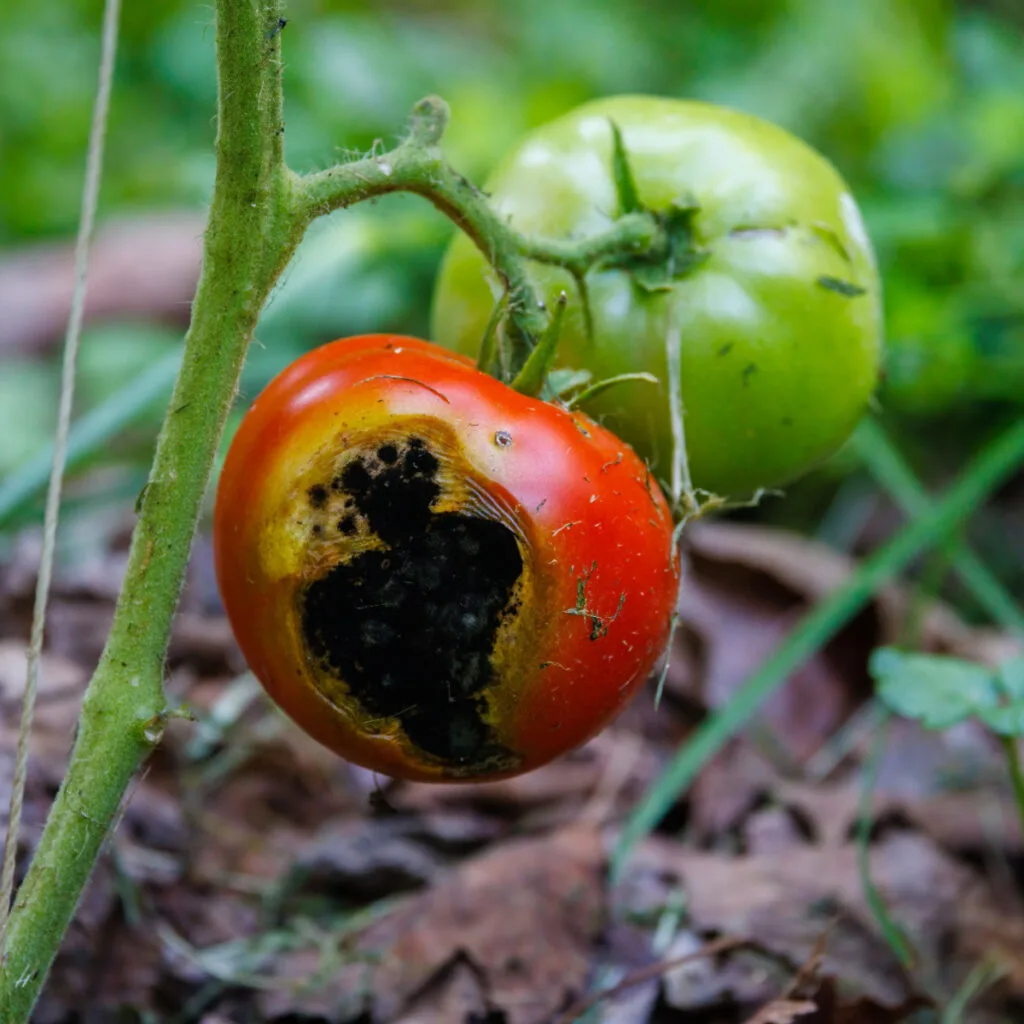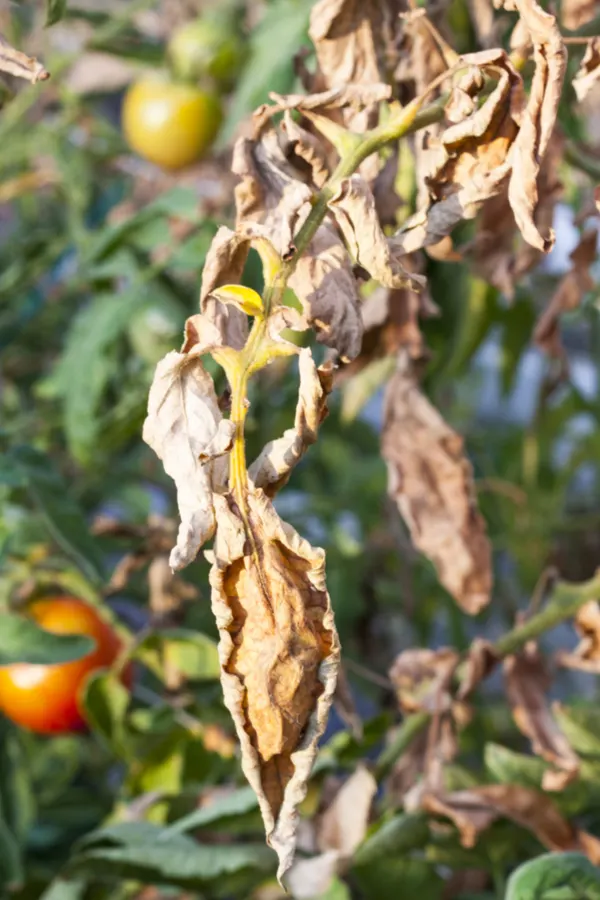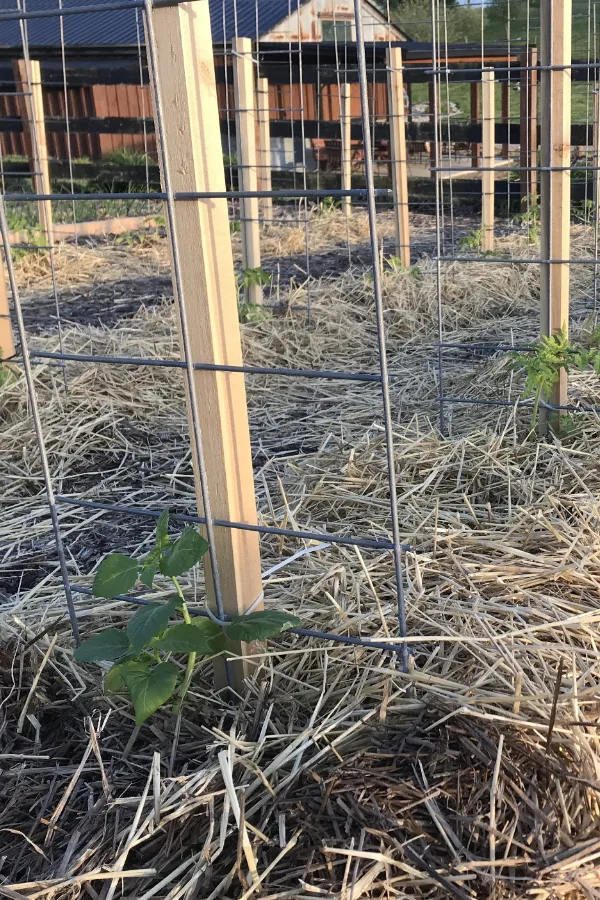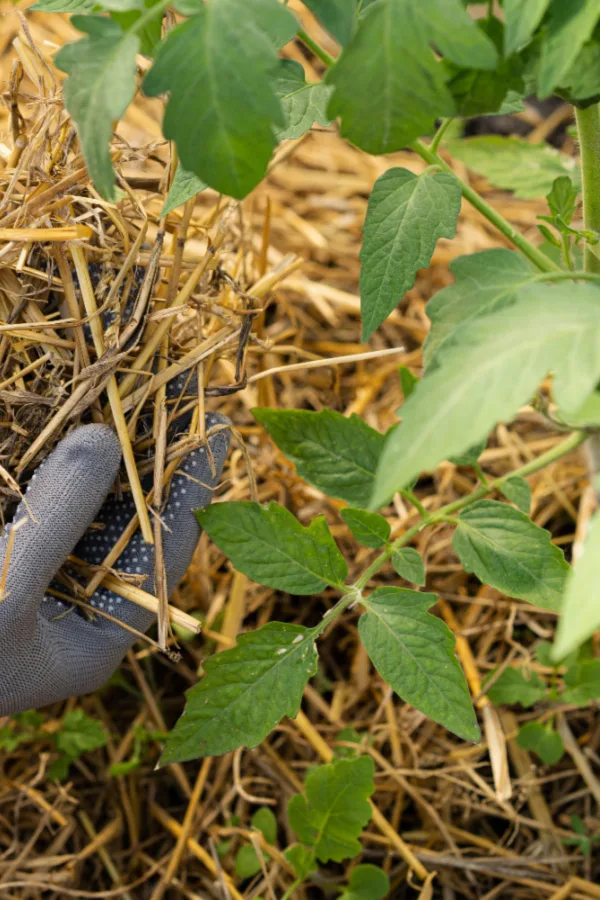Looking to prevent tomato blight from ruining your tomato plants and harvest this year?
Tomato blight is a soil borne, fungal disease that attacks plants by destroying the foliage and eventually the tomato fruit on otherwise healthy tomato plants. There are actually two types of blight, early season blight, and late season blight. Although both are very harmful to plants, late season blight is by far the most deadly.
Early season blight will usually show its symptoms when tomatoes first start forming on your plants. It starts with a few small brown scars on the foliage. Next, the foliage turns yellow, and then finally brown as it dies off.
Early blight will not kill the plant entirely, nor the tomatoes. But if left unchecked, most of the foliage will die off from early blight. It results in plants that simply can’t grow with any strength. Even more, it also usually leads to very few tomatoes on the plant at harvest time.

Late season blight is much more difficult and deadly to the entire plant. Unfortunately, once the symptoms appear, there is little you can do except remove the plants. Late blight starts on the edge of leaves as black spots or black curls.
From there, it takes over the plant, including the fruit as well. Eventually, the entire plant will lose its cover of foliage and the plant dies. Almost always, the entire harvest is compromised with late season blight.
The Effects Of Blight – How To Prevent Tomato Blight For Good!
Tomato blight can be a serious short and long term issue for gardeners. Not only does it quickly decimate seemingly healthy plants in just a matter of weeks, it can also spread with lighting quickness from plant to plant, wiping out an entire crop of tomatoes
Making matters worse, once blight establishes in the soil, it can easily live on and continue to ruin plants for the next three to five years! But as deadly as blight can be, there are two very simple things you can do to help keep it from ever finding its way to your tomato crop – or into your garden’s soil.
The good news is that each of them work not just against early season blight, but late season blight as well. But the best news of all is that they also both couldn’t be more easy to do!

2 Simple Ways To Prevent Tomato Blight For Good!
Rotate Your Crops
Because blight is a soil-borne disease, it relies on the soil to keep its spores alive from year to year. And once established, the spores can remain alive for multiple years. They simply overwinter and lie in wait to infect the following year’s plants.
But by simply moving and rotating your plants from year to year in your garden, you can disrupt the process. When tomato plants grow in new soil, the spores do not have easy access to find their way on to the plants leaves. Because of that, the chance of blight occurring drops dramatically.
This applies not only in a traditional garden but in raised beds and containers as well. You simply never want to plant your tomatoes in the exact same soil they grew in last year. See our article: How To Plant Tomatoes In 5 Gallon Buckets – Grow Tomatoes With Ease!
This is actually great advice not just to prevent blight, but to grow far healthier and more productive tomato plants. Tomato plants are heavy feeders from the soil. Because of that, they can deplete the soil’s nutrient levels quickly. But by moving them to a new space, they find new nutrients – all while the old growing space has time to recover.

For the best protection against blight, tomato plants should not grow in the same location or soil for at least 3 years. If your plants have become infected with blight, it’s best to leave that space tomato free for at least 5 years to allow the spores to die off.
Mulch Your Tomato Plants – How To Prevent Tomato Blight For Good!
Rotating your crops is a huge first step to preventing blight, but if you really want to keep blight from hitting your plants for good, you also need to mulch your plants. And do so as soon as you plant!
When blight spores are present in the soil or find a way there by blowing in from other areas – they get to plants not through the roots in the soil, but by being splashed up onto the foliage. This happens most frequently when it rains, or you hand water your plants.
But by covering the soil below the plants with mulch, you greatly diminish the opportunity for spores to find a home. For maximum effectiveness, mulch the soil around your plants with a thick 4 to 6 inch thick covering of straw, shredded leaves or grass clippings.
Not only will this help reduce the chance of blight, it also has a slew of additional benefits for your tomato plants! Mulch helps suppress competing weeds and keeps moisture in the soil. It also keeps the soil temperature regulated to minimize the stress on your tomato plants from cool nights and scorching hot days.
Staking & Pruning Plants – How To Prevent Tomato Blight For Good!
Rotating your crops and mulching are by far the two most important steps you can take to eliminate blight. But there are a couple of other things that certainly help as well – and two of the best are staking your plants – and pruning up the limbs closest to the ground.
Staking or supporting plants with a cage or trellis helps to keep foliage from sprawling on the ground and touching spores. The best time to support tomato plants is right when you plant them. Waiting until later can not only allow them to fall over and break limbs – but it can also damage growing roots as you drive in the stakes.
In addition to giving the plants support, keep the base of your tomato plants pruned up as they grow. Low branches that allow the foliage to touch the ground are an easy path for spores to find a home. Pruning also helps keep your plants safe from toppling over due to excessive weight.

Keep Tomato Plants Out Of Your Compost Pile – How To Prevent Tomato Blight For Good!
Last but not least, although it may seem like a good idea, tomato plants should never be put in a compost pile at the end of the season. In addition, leave out any branches or stems you prune off during the season as well.
Tomato plants are notorious for harboring pests and disease. Of course, blight certainly falls in that category. Unfortunately, most home compost piles never reach hot enough temperatures to kill the spores that cause blight.
At season’s end, pull your plants and remove them from the garden. Be careful when you pull them out to not place them down on nearby soil. Instead, place them into a wheelbarrow or bucket and remove completely from the space.
Here is to preventing tomato blight in your garden this year – and to an amazing harvest of tomatoes too! Happy Gardening – Jim and Mary.
Old World Garden Farm
Jim and Mary Competti have been writing gardening, DIY and recipe articles and books for over 15 years from their 46 acre Ohio farm. The two are frequent speakers on all things gardening and love to travel in their spare time.
As always, feel free to email us at thefarm@owgarden.com with comments, questions, or to simply say hello! You can sign up for our free email list in the subscribe now box in the middle of this article. Follow us on Facebook here : OWG Facebook. This article may contain affiliate links.

